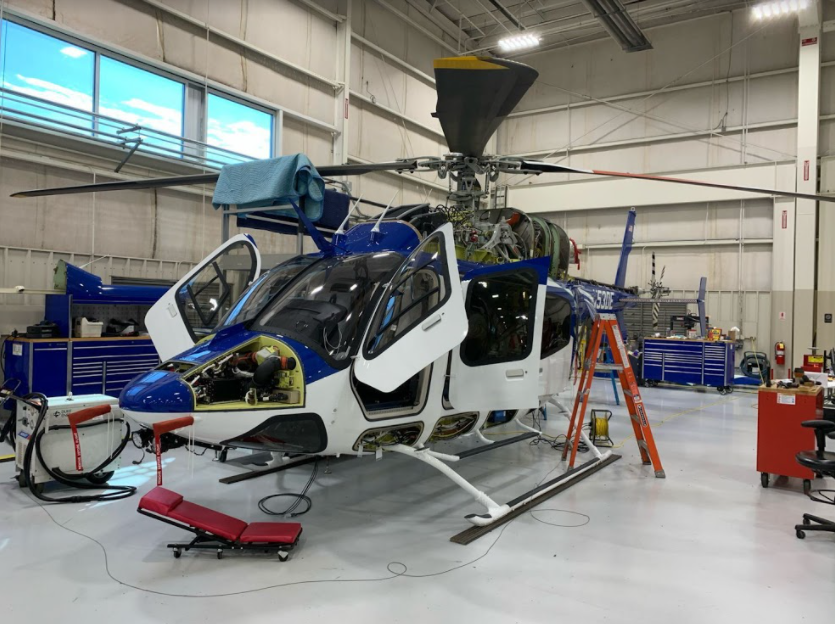|
Mar
29
2021
|
|
Posted 4 years 248 days ago ago by Admin
|
|

By inventing technological advances that allow Health, Usage and Monitoring Systems (HUMS) to expand to the smallest of rotorcraft, GPMS is democratizing a powerful tool that not long ago was reserved only for heavy helicopters.
GPMS launched its compact, speedy and lightweight next-gen Foresight MX in 2018, and it's already proving its worth many times over.
GPMS co-founders Eric Bechhoefer and Jack Taylor met at Goodrich (now Collins Aerospace), where they worked on first-generation HUMS that weren't feasible for 95 percent of aircraft because they cost hundreds of thousands of dollars, weighed more than 100 pounds, and required signal processing experts to interpret data. A former Naval aviator, Bechhoefer decided he was going to re-engineer and put the product within reach of all sizes of helicopter.
"We dropped it from more than 100 pounds to less than seven pounds," Bechhoefer said – even after including flight data monitoring (FDM) capabilities. "It's a little bit like the farmer at the dawn of the mechanization age and we’ve built the first great tractor."
While a minority of helicopters now feature onboard HUMS and FDM, within five years they will be the majority, predicted Andrew Swayze, GPMS head of marketing and strategy.
Foresight utilizes its own specially designed smart sensors as well as the aircraft's parameter data (analog or digital) to monitor fleet health and display it on one dashboard. This enables GPMS to democratize system monitoring in another way as well, because now everyone on the team can use Foresight at any location with any device that has browser-compatible software and access to the cloud.
Foresight's unique combination of HUMS and FDM data, light weight, and predictive capabilities are what really make it stand out, Swayze said. Proprietary algorithms provide Remaining Useful Life calculations so mechanics have plenty of lead time to order and replace parts during regularly scheduled maintenance.
"I look at this as a maintainer's tool," Bechhoefer said, citing the huge reduction in troubleshooting. "All the steps have been removed so that he can take action based on the data that's displayed and not spend days and weeks validating the signal."
And Foresight can pinpoint a problem before any human ever could, said Josh Kethan, GPMS customer success manager and former career helicopter mechanic. He cited a soft gear tooth as an example. "Foresight is essentially listening to the dynamic force. There are defects that can happen with a gear tooth that you can't see even if you have it in your hand, even with a microscope."
The reduction in down time translates into more revenue, of course. Foresight is proven to deliver two times the return on investment after the first year. For example, Foresight produces a 5-6% reduction in operational costs just by eliminating the need for RTB adjustment flights, Bechhoefer said. And when you can take the engine out before it's generating metal, you significantly reduce overhaul costs.
"Operators spend less time doing maintenance and more time generating revenue," Bechhoefer said. "That's really the key. We're finding things proactively and replacing them before they get out of hand." In fact, Foresight has uncovered significant issues on 70 percent of the aircraft where it's installed, Bechhoefer said.

SAFETY IS ANOTHER HUGE BENEFIT
The system offers two major points of information, Swayze noted: "How that aircraft is operating, and how it's being operated."
So alongside real cost savings, Foresight fulfills a critical safety need. When the International Helicopter Safety Foundation analyzed more than 1,000 helicopter accidents, it came up with eight initiatives to improve safety and HUMS was one of them.
Foresight adds even more safety value by acting as an excellent training tool. If a pilot does something especially well – or badly – the team can fly Foresight data through the X-Plane flight simulator, make comments and use it for training.
"They can re-fly the entire mission and see what led into that situation and how they got out of it – which is pretty valuable," Bechhoefer said.
Managers can track flight details real-time as well. So if a pilot over-torques on takeoff, for example, managers can see it and ask what happened.
Data automatically uploads to the cloud at the end of each flight via Cellular of WiFi; no more pulling the FTD card and downloading data manually. Foresight then immediately sends SMS and email alerts, but only if it spots a problem. That includes too much vibration, because maintaining lower vibration is good for the pilot and passengers as well as the overall reliability of the aircraft.
Bechhoefer is keenly aware of the need to keep unnecessary or false alerts to the lowest number possible.
"A false alarm is the death of these systems," Bechhoefer said. An operator is angry the first time it happens; the second time, he'll slap black tape over the offending equipment. "So I designed the system to have a false alarm rate of one in a million," he said, quickly adding, "If anyone tells you they never have a false alarm, they're lying because you can't have a detection process without it."
GPMS secured its first FAA STC on the light Bell 407 in collaboration with Bell, then quickly launched its product with Duke Energy. After testing Foresight on one rotorcraft in 2018, Duke was sold on the product. Duke went full in the following year, installing Foresight on its entire fleet.
“From the start, we were excited about GPMS’s Foresight HUMS as a next-generation offering. We were really struck with the impact this tool had on our fleet," said Ron Hughes, Duke Energy manager of aviation maintenance. "Having experienced Foresight, our maintenance techs have become real advocates for the system.”
CASE STUDY: AWAY FROM HOME
Real-life stories may be the best way to illustrate the benefits of the Foresight MX predictive HUMS system. Bechhoefer already has plenty of these stories only a few years after introducing his invention.
One event involved a pilot who was hundreds of miles away from his home base while conducting power line inspections. He called in to report low engine power, and requested a maintenance test to see if the aircraft was safe to fly.
Before having the Foresight tool, the chief mechanic would have needed to fly out to the helicopter with his tools and inspect it in person, taking him away from his base duties and leaving the helicopter temporarily out of service.
But instead, Foresight allowed the mechanic to assess the helicopter remotely. He logged on to the Internet to review the machine and flight data that Foresight had automatically uploaded to the cloud and transformed into an interactive dashboard. The mechanic noticed an orange health indicator in the mechanical diagnostics area of the dashboard. Digging into the diagnostics a little deeper, he could see that engine performance was trending dramatically upward, indicating a loss of power.

Using his experienced intuition, he clicked over to the exceedances and FDM data. Scanning more than 30 parameters tracked by Foresight, he chose outside air temperature and saw that OAT had dropped over the course of the flight to -5 F, then increased as the aircraft descended.
The mechanic hypothesized that the pilot had turned on bleed air to warm up the cockpit during the polar vortex. The pilot confirmed his hypothesis.
"Knowing that a 7% drop in engine performance was within normal range when bleed air is on, the mechanic was able to confirm that the aircraft was safe to fly – all without leaving the hangar," Bechhoefer related. "When you add up incremental productivity (revenue) and potential trip costs (savings), this incident had a net benefit to our customer of several thousand dollars."
EVOLVING eVTOL INDUSTRY WILL INCREASE HUMS VALUE
As eVTOL public transportation transitions from the future toward reality, that industry will drive demand to increase cost savings and safety utilizing constant HUMS monitoring, Bechhoefer said; those advances also will benefit the traditional helicopter industry.
"If we want to scale eVTOL up to all of society having access to it, we also have to make progress on safety," Kethan said. "And to do that, it's going to take a tool like Foresight" that can constantly monitor onboard components without the need to disassemble them for inspections. "We can inspect an aircraft without ever having to touch it. We're inspecting aircraft basically every day."
Regulations could force more use of HUMS and FDM, but incentives such as insurer discounts could precede that, Kethan said.
HUMS will be key to any transition from scheduled TBO to extended TBO with on-condition maintenance, Bechhoefer added. He predicts companies will figure out ways to use HUMS to extend TBOs, and GPMS will be in the thick of it.
The GPMS team already is working on its next innovations in its five-year plan, as they are hard at work on STCs for the AS350, Bell 212/412, Bell 429, and MD530 among others. Besides making the system faster with broader coverage, Bechhoefer envisions making a mechanic's work even more seamless by adding a communications module that allows him to command an RTB acquisition directly from his mobile phone immediately after pinpointing a problem.